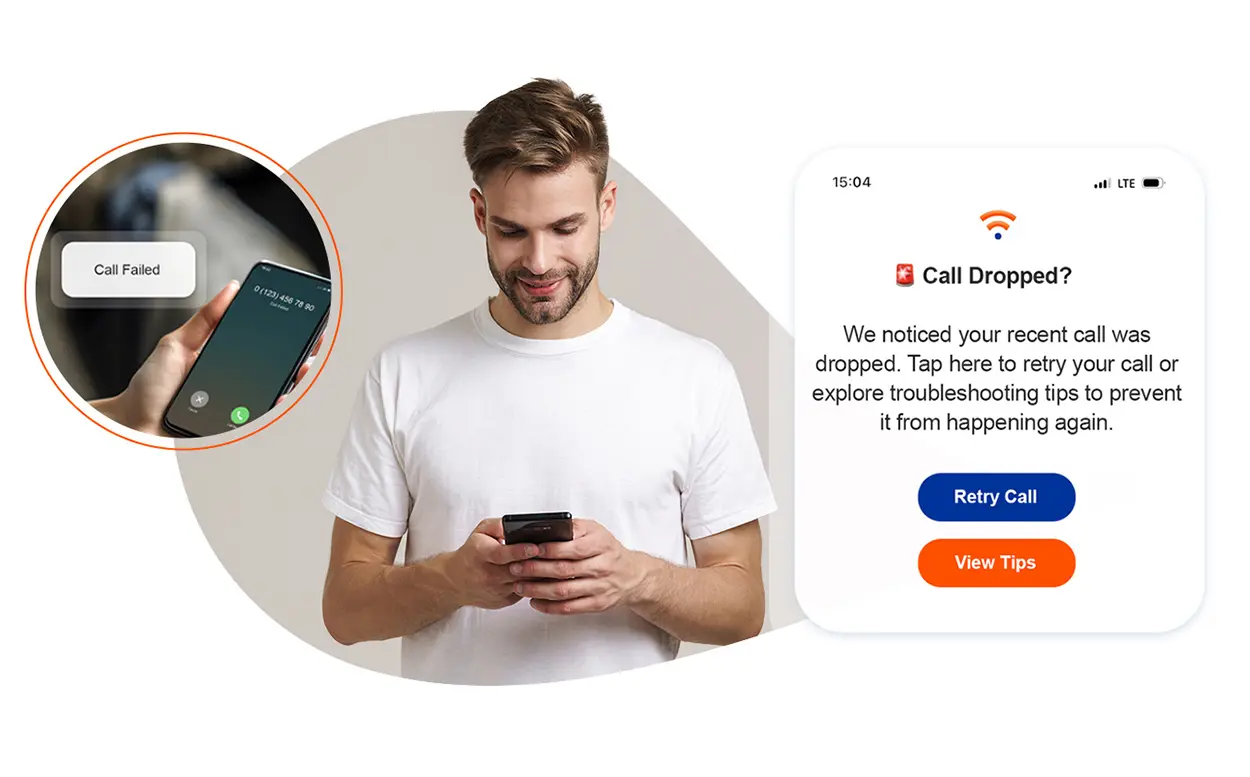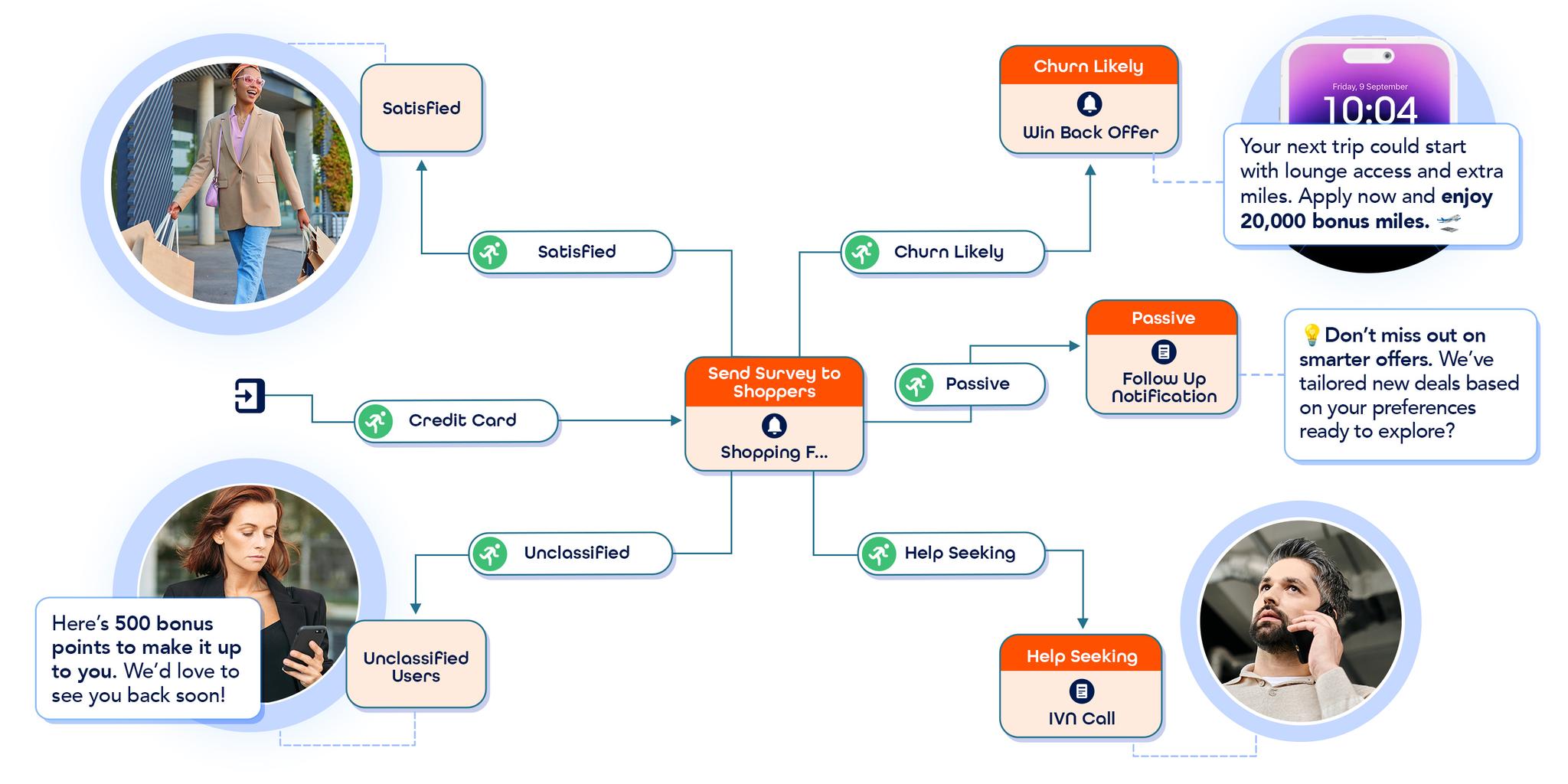- What Is Behavioral Triggering?
- How Behavioral Triggering Works in Telecoms
- 1. Data Collection
- 2. Real-Time Triggers
- 3. Personalization
- The Role of AI in Telecom Marketing
- 1. Predicting Customer Behavior with AI
- 2. Real-Time Personalization at Scale
- 3. Streamlining the Process with Automation
- 4. AI Insights for Continuous Optimization
- Telecom Strategies for Upselling with Behavioral Data
- 1. Personalized Offers
- 2. Proactive Solutions
- 3. Engaging at the Right Moment
- 4. Cost-Effective Upsell Strategies
- Key Benefits of Behavioral Triggering and Contextual Marketing in Telecom
- 1. Maximizing ROI
- 2. Increased Customer Retention
- 3. Enhanced Cross-Sell Opportunities
- 4. Improved Customer Experience (CX)
- 5. Efficient Scaling of Marketing Efforts
- evamX: Unlock the Power of Behavioral Triggering for Telecoms
In an industry as competitive and fast-paced as telecom, staying ahead of customer needs is crucial for retention and driving new revenue streams. As more telecom companies look for innovative ways to grow their customer base and increase revenue, behavioral targeting has emerged as a powerful tool.
By using real-time customer data to trigger personalized offers, telecoms can not only enhance the customer experience, but also significantly boost their upsell opportunities.
In this post, we’ll look at the benefits of behavioral triggering in telecom, explore how it works in real-time, discuss telecom upsell strategies, and examine why AI is the game-changer in maximizing upsell success.

What Is Behavioral Triggering?
Behavioral triggering is the practice of using real-time data to identify and respond to specific actions, needs, or patterns exhibited by customers. For telecom companies, this could mean monitoring how customers use their services, when they’re nearing their data limits, or when they’re engaging with particular products or features.
By analyzing this behavioral data, telecoms can trigger personalized offers at exactly the right moment, such as offering a data plan upgrade when a user approaches their data cap, or suggesting a new service that aligns with their preferences and usage patterns.
The key here is real-time responsiveness. Rather than waiting for customers to make the first move, telecoms can initiate interactions that feel timely and relevant. This shift from a broad, reactive approach to a more proactive, personalized one leads to enhanced telecom customer engagement and better outcomes for both users and businesses.
How Behavioral Triggering Works in Telecoms
Behavioral triggering is all about leveraging real-time customer behavior analysis to identify specific behaviors and then responding with personalized offers or actions.
1. Data Collection
Telecoms have a wealth of data at their disposal. Whether it’s call logs, service usage statistics, payment history, or device information, all this data provides insight into how customers interact with their services.
For instance, if a customer has been using more data than their plan allows, a telco could track that usage pattern and predict they’ll likely need a data plan upgrade soon. Similarly, if a customer consistently uses a particular service, such as mobile hotspots, or specific apps like streaming or gaming, behavioral triggers can detect those preferences and suggest an appropriate upsell.
2. Real-Time Triggers
Personalized offers for telecom customers can be delivered on their current behavior, rather than waiting for them to reach out first or make a decision.
For example, when a customer reaches 90% of their data usage limit, a system might trigger an upgrade offer, alerting them to the possibility of a better plan before they experience any service interruptions. This real-time response helps telecoms stay ahead of the customer’s needs, offering solutions before issues arise.
3. Personalization
Each customer is unique, with distinct usage patterns, preferences, and needs. A telecom provider can’t afford to offer the same generic plan to every customer. Instead, using insights from behavioral data, telecoms can send tailored offers that align with each customer’s specific behaviors.
For example, a heavy user of data might be interested in an unlimited data plan, while someone who frequently uses international calling may need an upgraded plan with better international rates. By offering the right solution to the right person, telecoms dramatically increase the chances of a successful upsell.
The Role of AI in Telecom Marketing
Now that we’ve covered how behavioral triggering works, let's dive into how AI amplifies its power. AI doesn’t just help telecoms analyze customer data, it enhances the process by providing insights, automating responses, and scaling personalized marketing efforts across a large customer base.
1. Predicting Customer Behavior with AI
AI-powered systems analyze vast amounts of data to identify predictive patterns in customer behavior. For instance, it can detect when a customer is nearing their data cap or has been engaging with a particular service repeatedly.
AI doesn’t just react to this data, it predicts the next step. If a customer is likely to upgrade their plan based on usage patterns, the AI can trigger a personalized offer to meet their needs.
2. Real-Time Personalization at Scale
Rather than manually segmenting customer groups and crafting individual campaigns, AI can process massive amounts of data and generate personalized offers for every customer. As customer behaviors change, AI continuously adapts to offer the most relevant recommendations.
3. Streamlining the Process with Automation
Once the right offer is identified, AI can automatically trigger it through multiple channels, such as email, in-app messaging, SMS, or customer support interactions. This trigger-based marketing automation significantly reduces manual intervention and ensures that offers are delivered instantly when the customer’s behavior warrants it.
4. AI Insights for Continuous Optimization
AI doesn’t just stop at execution, it provides valuable insights that help telecoms continuously improve their upsell strategies. By analyzing which offers are most successful, AI helps refine future campaigns. Over time, the system learns what works best, continuously optimizing for higher conversion rates and better customer experiences.
Telecom Strategies for Upselling with Behavioral Data
In a competitive telecom market, finding ways to increase revenue without constantly acquiring new customers is crucial. Behavioral triggering offers a proven path to boost upsell success, turning everyday customer interactions into revenue-generating opportunities.
1. Personalized Offers
Personalization is the cornerstone of upsell success. Behavioral data allows telecoms to segment customers not by basic demographics, but by their actual behavior, ensuring that the upsell offer is not only timely but also highly relevant.
For example, if a customer frequently uses international calling or roaming services, they may be a prime candidate for a plan that offers better international rates or roaming benefits. A tailored offer that speaks directly to the customer's current usage patterns increases the chances of success because it aligns perfectly with their needs.
2. Proactive Solutions
Rather than waiting for customers to express dissatisfaction, behavioral triggering enables telecoms to anticipate needs and proactively address them. For example, if a customer is often calling customer service about network outages or slow speeds, telecoms could trigger an upsell for a premium plan that promises better coverage and faster speeds.
In addition to telecom churn prevention, by solving a potential pain point before it becomes an issue, telecoms improve the customer experience and increase the likelihood of a successful upsell.
3. Engaging at the Right Moment
Timing is everything in upselling, and behavioral triggering ensures that offers are presented when customers are most likely to be receptive.
For instance, imagine a customer who frequently buys on-demand movies or TV shows. A telecom provider could trigger an upsell for a premium TV package or a streaming bundle, offering it just after the customer purchases content. The key here is that the customer has already shown an interest in related services, making them more likely to convert. Other moments, like offering faster speeds for gaming to customers who frequently use online gaming services, can also be highly relevant and timely.
4. Cost-Effective Upsell Strategies
Behavioral targeting reduces waste in marketing campaigns. Rather than targeting every customer with the same offer, telecoms can focus on those who are most likely to need and accept an upsell, reducing the cost per acquisition (CPA) for each upsell opportunity. This makes upselling more cost-effective and efficient, helping telecoms increase average revenue per user (ARPU) without huge investments in broad advertising campaigns.
Key Benefits of Behavioral Triggering and Contextual Marketing in Telecom
Behavioral triggering isn’t just a way to boost upsell success. It offers a wide range of benefits that can transform a telecom’s overall marketing strategy.
1. Maximizing ROI
Traditional telecom marketing strategies often involve blanket promotions targeting large segments, many of which may not convert. Behavioral triggering, on the other hand, ensures that marketing dollars are spent more efficiently by targeting the right customers at the right time. With the help of AI and real-time data, telecoms can focus on customers who are most likely to convert, ultimately improving ROI on marketing campaigns.
2. Increased Customer Retention
Telecom companies face high levels of churn, but personalized, timely engagement can significantly reduce customer attrition. By proactively offering relevant solutions based on behavior, telecoms can increase customer satisfaction and create more loyal customers.
3. Enhanced Cross-Sell Opportunities
Behavioral data opens up a range of cross-sell opportunities in addition to upsell opportunities. By understanding a customer's current behavior, whether they’re using more data, exploring new services, or interacting with customer support, telecoms can offer additional services that improve the customer’s overall experience.
4. Improved Customer Experience (CX)
When customers receive offers that are aligned with their usage patterns, they feel that their telecom provider is truly addressing their needs. This increases engagement and satisfaction. A positive experience drives customer loyalty, which ultimately results in higher retention rates and more upsell opportunities over time.
5. Efficient Scaling of Marketing Efforts
As telecoms expand their customer base, behavioral targeting allows them to scale their marketing efforts without losing personalization. With AI and machine learning, telecoms can manage large volumes of data and customer interactions, ensuring that each customer receives an offer that feels just as personalized as it would in a small business setting. This scalability is crucial for growth and allows telecoms to expand without sacrificing quality of service.
evamX: Unlock the Power of Behavioral Triggering for Telecoms
Behavioral triggering is a game-changer for telecoms looking to boost upsell success, improve customer loyalty, and drive revenue growth. But to get the most out of this strategy, you need the right tools, insights, and expertise.
evamX specializes in helping telecom businesses harness the power of real-time data, AI-driven insights, and personalized offers to create seamless and effective upsell strategies. Our omnichannel platform with real-time campaign orchestration capabilities can help you implement behavioral triggers that deliver the right message at the right moment, increasing conversion rates and ensuring a superior customer experience.
evamX's solutions have been the driving force behind numerous success stories within the telecom industry:
evamX developed and configured 16 real-time triggers and launched 20+ real-time campaigns with Jazz, Pakistan’s leading digital communications company.
evamX helped Turkcell, a leader in Turkey’s telecommunications industry, double their next-best-offer acceptance rate.
Are you ready to take the next step with evamX to transform your telecom’s marketing success?








